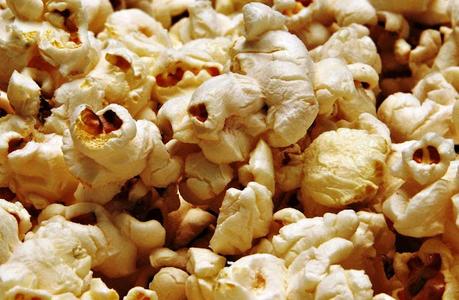Long long ago ! in 1980s, it used to be manufactured and packed and sold in a house in Thavana Uthsava bungalow – price 0.15 paise (while it would sell for 50 paise in theater – those were days when highest ticket was Rs.2.90 in Devi Paradise) – the ubiquitous ‘popcorn’.

Now a days whether one goes to the theater with a girlfriend or with family – in the interval one must stop in the long queue to buy few packets of popcorn – and savour its smell, that crunchy bit, masala salty kick, buttery finish ! – the kernels really pop our taste buds. To many watching a movie, without popcorn makes it incomplete. A recent video in tiktok states that there is no difference in small and medium popcorn tubs other than its packing. This man, working at theatres, explained through his video that the quantity of popcorn in a six-dollar medium tub is the same as the small one. If and when a person orders a medium tub popcorn instead of a small one the shopkeeper transfers the same popcorn from small container to medium. While the quantity in both remains the same. However, there is a considerable price difference between the two.
Popcorn (popped corn, popcorns or pop-corn) is a variety of corn kernel which expands and puffs up when heated; the same names are also used to refer to the foodstuff produced by the expansion. A popcorn kernel's strong hull contains the seed's hard, starchy shell endosperm with 14–20% moisture, which turns to steam as the kernel is heated. Have you ever wondered where popcorn comes from? As it turns out, the corn that we typically eat is different than the kernels that become popcorn. There’s only one variety of maize that will make it – Zea mays everta. Though it looks like a typical corn kernel, this particular variety is the only one that has the ability to pop and turn into a delicious snack.

Maize also known as corn is a cereal grain first domesticated by indigenous peoples in southern Mexico about 10,000 years ago. The leafy stalk of the plant produces pollen inflorescences and separate ovuliferous inflorescences called ears that yield kernels or seeds, which are fruits. Maize has become a staple food in many parts of the world, with the total production of maize surpassing that of wheat or rice. In addition to being consumed directly by humans (often in the form of masa), maize is also used for corn ethanol, animal feed and other maize products, such as corn starch and corn syrup. Maize is widely cultivated throughout the world, and a greater weight of maize is produced each year than any other grain. This is no post of agriculture or food items but one of Politics and History of our neighbouring Nation.
Rana dynasty is a Chhetri dynasty that ruled the Kingdom of Nepal from 1846 until 1951, reducing the Shah monarch to a figurehead and making Prime Minister and other government positions held by the Ranas hereditary. Rana dynasty is historically known for the iron-fisted rule. This changed after the Revolution of 1951 with the promulgation of a new constitution, when power shifted back to the monarchy of King Tribhuvan.
Makaiko Kheti (The Cultivation of Maize) is a 1920 literary work by Krishna Lal Adhikari. Adhikari had been inspired to write a book about maize cultivation after reading an Indian book that a friend had given him. With permission from Nepali Bhasha Prakashini Samiti, the book was released in July 1920, with 1,000 copies being printed. Detractors accused the book of containing double entendres which purportedly attacked the Rana dynasty that had ruled over the Kingdom of Nepal since 1846. Adhikari was sentenced to nine years in prison, where he died.
During the Rana rule in Nepal, government permission was required for publishing any writing. According to the National Code of Nepal (1854) passed by Prime Minister Jung Bahadur Rana, the book had to be given to the Nepali Bhasha Prakashini Samiti (Samiti), which would review it and grant permission to publish if it seemed appropriate. Anyone who was caught publishing or printing a document without permission was fined 50 Nepalese rupees; if the work contained anything that was deemed offensive to the Rana dynasty, all of the copies would be seized by the Samiti and most of the time destroyed.
Author Krishna Lal Adhikari had received permission from the Samiti prior to the book's release. He was working for the Rana government; reportedly he had asked Kaiser Shumsher Jang Bahadur Rana, son of Chandra Shumsher, who had given him the permission to publish the book. His friend had given him an Indian book about maize cultivation which inspired Adhikari to write a book about farming. It is not still clear whether the book was intended to be an agricultural manual or a political satire.
In the book, Adhikari detailed how to increase yield and protect the crop from termites; however, Makaiko Kheti contained many double entendres. At the time, the Rana dynasty had been ruling over the Kingdom of Nepal since 1846 and was censoring freedom of expression. The book included many metaphors that alluded to the Ranas. Some of the figures of speech included: "the red headed insects and black headed insects", "domestic and foreign dogs", "the devils entered since 1846", and "Chandrodaya is not as good as mother's milk to a child".
Two officials reported to Prime Minister Chandra Shumsher Jang Bahadur Rana about the book, blaming the author for "mischievous expressions to treason". This analysis was intended to satirize the linguistic anglicisation of the Ranas by saying that local dog fights to protect the corn from thieves, while the English dog looks better but it doesn't protect the crop. Chandra Shumsher was a pro-British politician who had built a bond between foreigners. The "red and black insects" offended Chandra Shumsher Jang Bahadur Rana and Bhim Shamsher Jang Bahadur Rana because they wore red and black topis, respectively.
On 2 August 1920, Adhikari was sentenced to nine years in prison; his sentence would be reduced to six years if he handed over all 1,000 copies of the book to the government. Adhikari tried to return all the copies but one had gone missing and he was unable to locate it !! All of the 999 copies were burnt ~ no surviving copies of the book were to be found. No court documents survive to indicate how Adhikari defended himself or if he admitted to committing treason. On 9 December 1923, Adhikari died of tuberculosis whilst in prison. Adhikari's arrest and death later became known as the "Makai Parva" (Maize Incident).
History is replete with interesting and life threatening events !
With regards – S. Sampathkumar
2nd Aug 2021.

